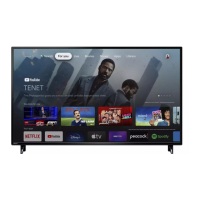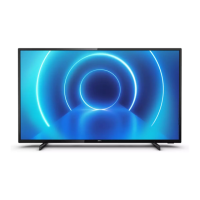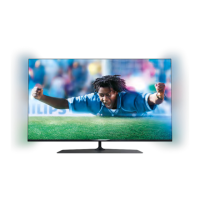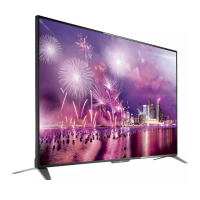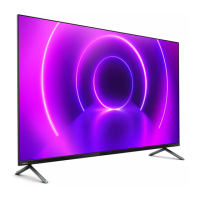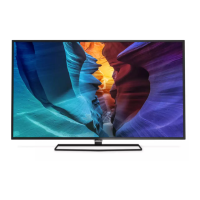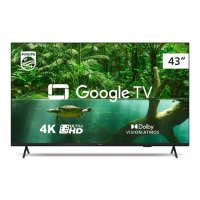
Do you have a question about the Philips 7408 Series and is the answer not in the manual?
| Display Technology | LED |
|---|---|
| Smart TV | Yes |
| Audio Output | 20W |
| Connectivity | Wi-Fi, Ethernet |
| Smart TV Platform | Android |
Provides an overview of the Google TV Home screen and its functionalities.
Explains the Dashboard panel and how to access TV settings for adjustments.
Differentiates between Basic and Full modes, detailing feature availability in each.
Step-by-step guide to accessing and navigating the TV's Home screen.
Crucial safety information to read before operating the television.
Instructions for installing the TV stand or mounting it on a wall.
Recommendations for placing the TV to ensure optimal viewing and airflow.
Guidance on securely connecting the power cable to the TV and outlet.
Steps for connecting the antenna cable to the TV for signal reception.
Detailed explanation of each button and its function on the remote control.
How to use the voice search feature for finding content and information.
Information about the infrared sensor and how to ensure proper signal reception.
Instructions for replacing batteries and cleaning the remote control.
Procedures for switching the TV on, off, and to standby mode.
Guide for installing channels during the initial TV setup process.
Steps to install channels using cable or antenna sources.
How to manually update the list of available TV channels.
Method to skip unwanted channels from the channel list.
Instructions for editing and managing the TV's channel list.
General information on switching between channels and sources.
How to view, sort, and filter channel lists.
Creating and managing lists of favorite channels for quick access.
Setting up parental controls to lock channels or programs.
General advice on connecting various external devices to the TV.
Connecting a Home Theater System, including HDMI ARC setup.
Connecting video playback devices like Blu-ray players via HDMI.
Connecting audio devices using optical output for sound.
Using USB flash drives to view photos, music, and videos.
Information on what is required to connect Bluetooth devices to the TV.
Step-by-step guide to pairing wireless Bluetooth devices with the TV.
How to select an already paired Bluetooth device for use.
Procedure to rename a connected Bluetooth device for easier identification.
Steps to unpair and remove Bluetooth devices from the TV.
Instructions for connecting the TV to a home network and the internet.
How to sign in and manage your Google Account for full TV features.
Overview of the Apps feature and how to find and install them.
Using Google Play for renting movies, music, and playing games.
How to launch, close, and manage running applications.
Tips for managing app cache and uninstalling unused applications.
Guide to switching between different input sources like tuners and USB drives.
Accessing main TV settings like Source, Picture, Screen, Sound, and Power.
Detailed settings for picture modes, brightness, contrast, and color.
Adjusting sound modes, Dolby Atmos, and other audio enhancements.
Managing accessibility, system updates, date, time, language, and keyboard.
Accessing advanced settings for audio, default channels, and Ginga.
Connecting and viewing files from a USB flash drive.
How to play video files, including playback controls and settings.
Viewing photos, managing thumbnails, and using photo frame options.
Playing music files with controls for repeat, shuffle, and lyrics.
How to preview and read text files from a USB drive.
Information on what is needed to view TV program schedules.
Explains how TV guide data is received from broadcasters.
Casting apps and content from mobile devices to the TV.
Information on accessing and using the Netflix streaming service on the TV.
Details on accessing and viewing content from Amazon Prime Video.
Technical details regarding power requirements and operating conditions.
Specifies the operating system version running on the TV.
Details about antenna input, tuner bands, and digital video/audio playback.
Screen diagonal sizes and the TV's native display resolution.
List of supported video and computer input resolutions and refresh rates.
Information on available ports (USB, HDMI, Antenna) and wireless connectivity.
Details on the TV's audio output power and sound processing features.
Lists supported USB file systems and playback formats for audio, video, and images.
Explains the advantages and process of registering the TV for support.
Solutions for common problems like TV not switching on or remote control issues.
How to find help, FAQs, and contact support via the Philips website.
Information on how to contact customer care for repairs and service.
Essential safety guidelines for preventing injury and electrical hazards.
Instructions for safely cleaning the TV screen and frame.
Outlines the terms of use, warranty, and pixel characteristics.
Copyright and trademark information for Google, HDMI, HEVC, and Dolby.
Trademark information for Wi-Fi Alliance, Kensington, and other trademarks.
Disclaimer regarding changes or termination of third-party services and software.
